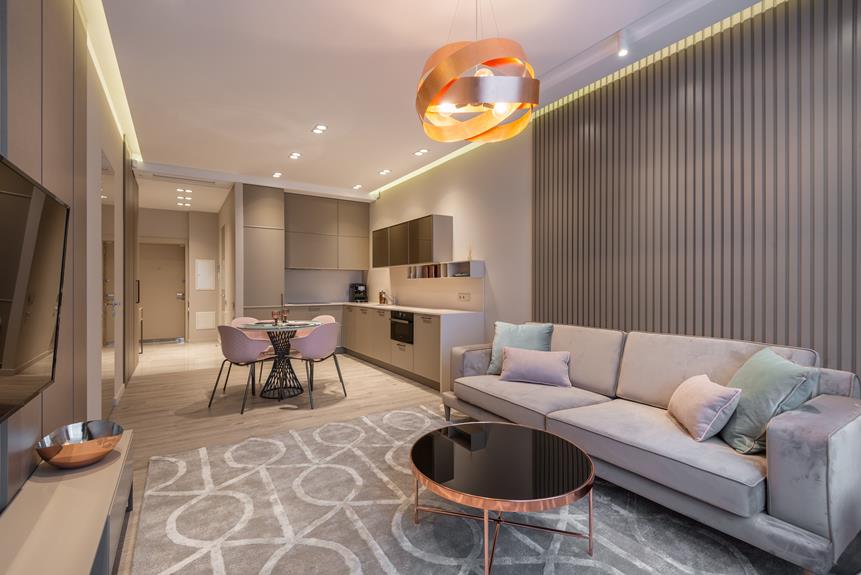In the current housing market, the phenomenon of McMansions has gained significant attention. These large, often extravagant houses have become increasingly popular among certain segments of homebuyers. McMansions are characterized by their generic design, mass production, and close proximity on small lots. While they may feature expensive materials on the front, the sides and back are often adorned with cheaper options. Despite their uniform appearance and limited outdoor space, these homes attract buyers who desire spacious interiors and impressive amenities.
Factors driving this big house trend include the availability of new construction, record-low interest rates, and aggressive marketing by builders. Additionally, the recent COVID-19 pandemic has further contributed to the demand for larger houses. However, some buyers are actively seeking well-designed, sustainable, and tasteful homes with larger footprints.
This article will explore the characteristics of McMansions, the driving factors behind the trend, and the preferences of homebuyers in today's market.
Key Takeaways
- McMansions are characterized by their huge and sometimes ostentatious mass-produced design, cookie-cutter appearance, and closely-packed neighborhoods.
- Factors driving the trend of buying large homes, including McMansions, include new construction, low interest rates, aggressive marketing, and the impact of the coronavirus pandemic.
- McMansions prioritize interior space and feature upscale amenities such as spacious rooms, high ceilings, gourmet kitchens, and walk-in closets.
- McModern homes, which are popular with tech-conscious, educated, younger buyers, reflect mid-century modern aesthetics and are sometimes built with sustainable materials.
Definition and Characteristics of McMansions
McMansions are large, mass-produced houses that often have a cookie-cutter design. They earned their nickname due to their generic style, close proximity on small lots, and mass production. One of the main design flaws of McMansions is their cookie-cutter appearance, which lacks individuality and uniqueness. Additionally, McMansions are often closely packed together in neighborhoods, resulting in limited privacy and small yards.
Another characteristic of McMansions is the use of expensive materials, such as brick or stucco, on the front of the house, while cheaper materials like vinyl siding are used on the sides and back. This design inconsistency can be seen as a flaw when compared to traditional homes that have a more cohesive and harmonious design.
Factors Driving the Big House Trend
The surge in demand for larger homes can be attributed to various factors such as new construction, spacious house development, and the influence of low-interest rates and aggressive marketing by builders.
Additionally, the impact of remote work on the big house trend cannot be ignored. With more people working from home, the need for dedicated office space and additional rooms for productivity has increased. This has led to a preference for larger homes with flexible layouts and ample space for work and play.
However, it is important to consider the environmental implications of McMansions. These oversized homes consume more resources during construction and require more energy for heating and cooling.
As the trend continues, it is crucial to balance the desire for spacious living with sustainable practices to minimize the ecological footprint of these homes.
Features and Amenities of McMansions
McMansions boast impressive amenities and spacious interiors, with an emphasis on large rooms, high ceilings, and upscale features. These homes prioritize interior space, offering big rooms and an array of impressive amenities. Upscale features commonly found in McMansions include multiple garages, gourmet kitchens, sunrooms, and walk-in closets. Enormous master bedroom suites with whirlpool tubs and separate showers are also common. Additionally, these houses often include walk-in pantries, laundry rooms, media rooms, and home offices.
Outside, McMansions often feature over-sized garage doors, gas fireplaces, and large decks. While these houses offer luxurious living, they are not without their design flaws. McMansions are often criticized for their cookie-cutter appearance, closely-packed neighborhoods, and tiny lawns. Furthermore, their large windows, high ceilings, and two-floor great rooms can result in inefficient and expensive heating and cooling. This has sparked a debate about the affordability and sustainability of McMansions compared to more modest housing options.
Comparison Between Mcmansions and Mcmoderns
When comparing the characteristics of McMansions and McModerns, these two types of homes differ in terms of size, design, and building materials.
- Size:
- McMansions are often known for their large and spacious interiors, with big rooms and high ceilings.
- McModerns, on the other hand, tend to be more compact and efficient in their use of space.
- Design:
- McMansions often feature cookie-cutter designs, with little architectural uniqueness.
- McModerns reflect mid-century modern aesthetics, appealing to tech-conscious, educated, and younger buyers.
- Building Materials:
- McMansions are often made with low-grade building materials, resulting in their outdated appearance.
- McModerns, in contrast, are sometimes built with sustainable materials, reflecting a growing interest in eco-friendly construction.
These differences in size, design, and building materials contribute to the appeal of these two types of homes to different demographics.
Avoiding McMansions and Preferences in Homebuying
Buyers in the housing market are increasingly seeking well-designed, sustainable, and tasteful homes with large footprints, avoiding the flashy and cookie-cutter appeal of McMansions.
When it comes to avoiding McMansions and making preferences in homebuying, there are a few key considerations. Building sustainable homes is a priority for many buyers, who are looking for environmentally-friendly features and materials that reduce their carbon footprint.
Architectural design considerations also play a significant role. Working with an architect who understands the scale of homes in the neighborhood can help avoid a flashy McMansion and maintain balance with the surrounding properties.
Additionally, buyers are looking for homes that are well-constructed and tastefully designed, prioritizing quality over size. By incorporating these factors, buyers can find the perfect home that meets both their aesthetic and sustainability goals.
Impact of the Coronavirus Pandemic on the Big House Trend
The coronavirus pandemic has undoubtedly had a significant impact on the ongoing trend of purchasing larger homes.
- Impact on housing market:
- The pandemic has caused a shift in the housing market, with homebuyers reevaluating their priorities and preferences.
- Many individuals and families are now prioritizing spacious homes that offer more room for remote work and virtual learning.
- The desire for larger living spaces has led to an increased demand for houses with home offices, dedicated study areas, and flexible floor plans.
- Changing homebuyer preferences:
- Homebuyers are now seeking properties that provide more outdoor space, such as larger yards or access to communal parks and green spaces.
- The pandemic has also highlighted the importance of having amenities like private gyms, home theaters, and outdoor entertainment areas.
- As remote work becomes more prevalent, proximity to urban centers and commuting distance are becoming less important, allowing buyers to consider larger homes in suburban or rural areas.
Future Outlook for the McMansion Market
The future outlook for the McMansion market indicates a shift towards more sustainable and well-designed homes with larger footprints. The impact of the pandemic on the big house trend has highlighted the importance of creating living spaces that are not only spacious but also environmentally conscious.
Homebuyers are now seeking homes that prioritize energy efficiency, eco-friendly materials, and smart home technologies. This shift is driven by a growing awareness of the need to reduce carbon footprints and preserve natural resources.
Additionally, the pandemic has emphasized the importance of functional and flexible living spaces that can accommodate remote work and virtual learning. As a result, future McMansions are likely to incorporate home offices, multipurpose rooms, and outdoor entertainment areas.
Frequently Asked Questions
Are Mcmansions Only Found in Suburban Areas or Are They Also Present in Urban Areas?
McMansions are not exclusive to suburban areas; they can also be found in urban areas. Pros of urban McMansions include spacious interiors and desirable amenities, while cons include their generic style and use of low-grade building materials.
What Are Some Common Architectural Styles of Mcmansions?
Some common architectural styles of McMansions include neo-colonial, neo-Tudor, and Mediterranean-inspired designs. Pros of living in a McMansion include spacious rooms and impressive amenities, while cons include cookie-cutter appearance and closely-packed neighborhoods.
Are Mcmansions Considered a Good Investment in the Real Estate Market?
McMansions may not be a good long-term investment due to their potential risks and drawbacks. These include their cookie-cutter designs, closely-packed neighborhoods, and inefficient heating and cooling systems, which could affect their resale value.
How Do Mcmansions Impact the Overall Aesthetic and Character of a Neighborhood?
McMansions can have a significant impact on the overall aesthetic and character of a neighborhood. Their large size, cookie-cutter designs, and close proximity to other homes can disrupt the visual harmony and cohesiveness of the community's architectural style. This can lead to a loss of neighborhood character and a decrease in property values for surrounding homes. Additionally, the construction and maintenance of McMansions often require the removal of trees and green spaces, further impacting the natural beauty of the neighborhood. Ultimately, the presence of McMansions can alter the neighborhood's visual landscape and diminish its overall appeal.
Are There Any Regulations or Guidelines in Place to Control the Construction of Mcmansions and Prevent Their Negative Impact on Communities?
Regulations and guidelines regarding the construction of McMansions vary by jurisdiction. Some communities have implemented zoning regulations, design guidelines, or size restrictions to control the negative impact of these large houses on neighborhoods and maintain community character.



Real wonderful information can be found on blog.Money from blog